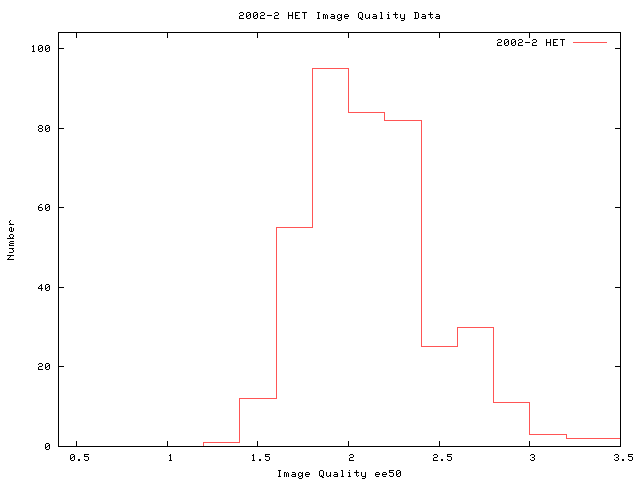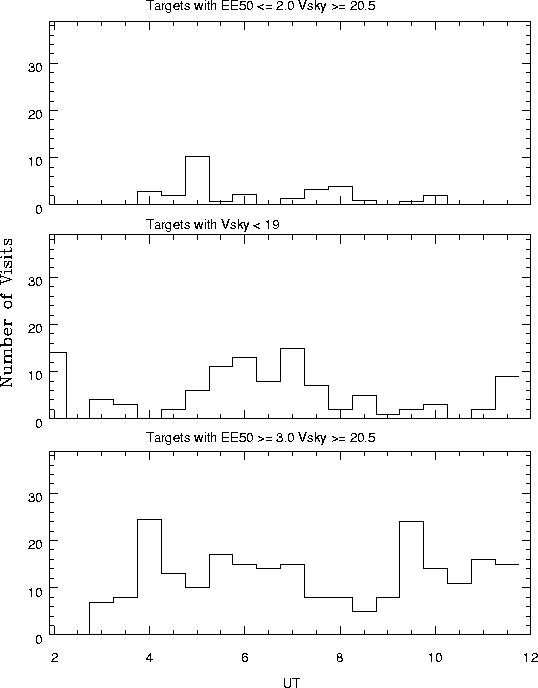
In this section we will discuss the status of each instrument and any limitation to configurations that occurred during the period.
The image quality of the HET has been improving each period. Here is a histogram from the last period.

For comparison here is the image quality for the period last year.

We expect to have a similar overhead to last period. The following overhead statistics include slew, setup, readout and refocus between exposures (if there are multiple exposures per visit). In the summary page for each program the average setup time is calculated. The table below gives the average setup time for each instrument PER VISIT and the average and maximum PROPOSED science exposures and visit lengths.
| Instrument | Avg Overhead (min) | Median Overhead (min) | Avg Exposure (sec) | Median Exposure (sec) | Max Exposure (sec) | Avg Visit (sec) | Median Visit (sec) | Max Visit (sec) |
|---|---|---|---|---|---|---|---|---|
| LRS | 14.6 (from last period) | 15.4 (from last period) | 629.9 | 600 | 2700 | 1008.4 | 600 | 4800 |
| HRS | 10.3 (from last period) | 9.5 (from last period) | 1051.6 | 1200 | 3000 | 1679.4 | 1300 | 5720 |
The overhead statistics can be shortened by multiple setups (each one counted as a separate visit) while on the same target as is the case for planet search programs. The overhead statistics can be lengthened by having multiple tracks that add up to a single htopx visit as can happen for very long tracks where each attempt might only yield a half visit.
A way to improve the overhead accumulated for programs with long exposure times is to add double the above overhead to the requested visit length and make sure that time is shorter than the actual track length. This avoids the RA having to split requested visits between several different tracks.
The following links give the summary for each institution and its programs.
The resulting table will give (for each program) the total number of targets
in the queue and the number completed, the CCD shutter open
hours, average overhead for that program, and the TAC allocated time.
This usually will be the best
metric for judging completeness but there are times when a PI will tell
us that a target is "done" before the total number of visits is complete.
This is how each institution has allocated its time by priority.
Observing Programs Status
Program comments:
UT03-2-003: (Gerardy) TOO SN
UT03-2-004: (Wheeler) TOO SN
UT03-2-005: (Wheeler) TOO GRB
UT03-2-006: (Drory) LRS MOS 3 targets left over from last period.
UT03-2-007: (Tufts) LRS MOS 1 target left over from last period.
UT03-2-011: (Prieto) HRS twilight program
UT03-2-013: (Robinson) priority 2 with 15 visits to same target under EE50<2.2 Dark, Photometric conditions
UT03-2-015: (Cochran) TOO planet search
UT03-2-016: (Barnes) priority 0 Synoptic EE50<2.0 dark HRS Photometric
Program comments:
PSU03-2-001: (Eracleous) TOO GRB
PSU03-2-002: (Schneider) No Phase II received
PSU03-2-003: (Brandt) Synoptic Bi-monthly G2 targets
PSU03-2-015: (Vignali) Synoptic with Chandra observations
PSU03-2-019: (Lewis) MRS targets
PSU03-2-023: (Ciardullo) MRS targets
PSU03-2-024: (Chakraborty) MRS target late in trimester
PSU03-2-027: (Stark) MRS targets
PSU03-2-028: (TAC) Flexible TAC allocation
Program comments:
STA03-2-002: (Petrosian) LRS MOS
STA03-2-003: (Thompson) On hold. Target observed in last period.
Program comments:
MUN03-2-001: (Thomas) Priority 0 LRS G2 targets
MUN03-2-002: (Hopp) LRS G2 or G3 targets
Program comments:
G02-3-004: (Hessman) Synoptic target still carried over from previous periods
G03-2-001: (Kollatschny) LRS synoptic target, 24 visits with 1-2 day interval
Institution Status
| Time Allocation by Institution (hours) | |||||
|---|---|---|---|---|---|
| Institution | Priority 0 | Priority 1 | Priority 2 | Priority 3 | Priority 4 |
| PSU | 6.000 (5%) | 26.800 (21%) | 26.700 (21%) | 27.000 (21%) | 42.830 (33%) |
| UT | 21.160 (13%) | 29.500 (18%) | 44.800 (27%) | 41.000 (24%) | 29.000 (18%) |
| Stanford | 0.000 | 7.000 (32%) | 7.000 (32%) | 4.000 (18%) | 4.000(18%) |
| Munich | 0.000 | 0.000 | 0.000 | 0.000 | 0.000 |
| Goetting | 0.000 | 0.000 | 0.000 | 0.000 | 0.000 |
| NOAO | 0.000 | 31.220 (56%) | 18.360 (33%) | 6.000(11%) | 0.000 |
| SALT | 0.000 | 0.000 | 0.000 | 0.000 | 0.000 |
| DDT | 0.000 | 0.000 | 0.000 | 0.000 | 0.000 |
| UT03-2 | ||
|---|---|---|
| Rank | Program | Constraints |
| 1 | UT03-2-005 | TOO GRB LRS g1 target |
| 2 | UT03-2-007 | LRS MOS targets, Vsky > 20.2, EE50 < 2.5 |
| PSU03-2 | ||
|---|---|---|
| Rank | Program | Constraints |
| 1 | PSU03-2-001 | TOO GRB LRS g1 target |
| 1 | PSU03-2-002 | bi-monthly Synoptic LRS g2 targets |
| STA03-2 | ||
|---|---|---|
| Rank | Program | Constraints |
| 1 | STA03-2-002 | LRS G1 MOS, Vsky > 20.5 , EE50 < 2.2 |
| MUN03-2 | ||
|---|---|---|
| Rank | Program | Constraints |
| 1 | MUN03-2-001 | 3 priority 0 LRS g2, Vsky > 20.7, EE50 < 3.0, |
| 2 | MUN03-2-002 HS0838+6253 | LRS g3 , Vsky > 20.5, EE50 < 3.0, |
| G03-2 | ||
|---|---|---|
| Rank | Program | Constraints |
| 1 | G02-3-004 | HRS, Synoptic target every 3-7 days for entire trimester, Vsky > 20.0 , EE50 < 3.0 |
| 2 | G03-2-001 | LRS g2, Synoptic target every 1-2 days for 24 visits, Vsky > 18.0 , EE50 < 4.0 |

The following histogram shows some of the extrema in observing conditions: good seeing dark time, bright time and bad seeing dark time. There will be a problem later in the trimester with a lack of bright time targets.
